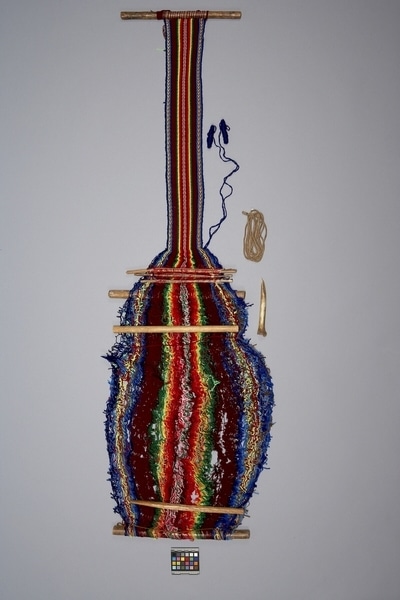Loom Item Number: Sf1018 a-g from the MOA: University of British Columbia

Description
Loom (part a-g) consisting of a partly woven belt with unwoven warps, attached shedding devices and accompanying wooden and bone tools. The symmetrically striped warp and belt section has three chevron bands flanked by rainbow colour stripes set against a dark red ground. There are cylindrical loom bars at each end; the bottom bar is part c. In the middle are three sticks with string heddles and a shed roll (part b). In addition, there is one stick with a flattened point and another straight (part d), round stick for rolling the cloth (part e). Two small skeins of blue yarn extend from each side of the woven web at the final row. There is a slightly smoothed bone pick (part f) and a length of brown cords (part g) is used to tie the bundle together.
History Of Use
Warp-faced fabric with three or four selvedges are woven by women but the fabrics are used by both sexes. The techniques, structures and some of the motifs have pre-Conquest antecedents. This type of textile conveys the most information about an individual's ethnicity, sex, age, status and particular history. Firm belts of this type are worn by women particularly during pregnacy and for 2 to 7 months afterwards. During pregnancy, they are bound tightly to keep the baby's head from growing too large and making the birth difficult. After birth, the heavy belt supports weakened muscles.
Specific Techniques
The commercial synthetic yarns are retwisted. The belt is woven to its finished dimensions on the continuously wound warp. The weave structure is a warp faced 2:2 twill.
Narrative
Silvia was making a kili chumpi or heavy belt for her pregnant sister Eufrasia. She stopped working on it when the baby was born dead. She makes belts for herself and for both her younger sisters, because according to Silvia, they do not know how to make their own.
Iconographic Meaning
Chevron design is called kili
Cultural Context
weaving
Item History
- Made by Silvia Yucra Huatta (Maker) in Taquile, Puno, Peru during June 1987
- Collected by Mary Frame during 1987
- Owned by Mary Frame before November 3, 1987
- Received from Mary Frame (Seller) and Museum of Anthropology Shop Volunteers (Funding source) on November 3, 1987
What
- Name
- Loom
- Identification Number
- Sf1018 a-g
- Type of Item
- loom
- Material
- synthetic fibre, wood, bone and dye
- Manufacturing Technique
- retwisted and woven
- Part A
- height 186.3 cm, width 41.6 cm
- Part B
- height 40.3 cm, diameter 2.5 cm
- Part C
- height 39.6 cm, diameter 2.1 cm
- Part E
- height 33.4 cm, width 1.8 cm, depth 1.4 cm
- Part F
- height 16.7 cm, width 2.6 cm, depth 2.5 cm
- Part G
- height 231.4 cm, width 0.7 cm
Who
- Culture
- Quechua
- Creator
- Silvia Yucra Huatta (Maker)
- Field Collector
- Mary Frame
- Previous Owner
- Mary Frame
- Received from
- Mary Frame (Seller) and Museum of Anthropology Shop Volunteers (Funding source)
Where
- Holding Institution
- MOA: University of British Columbia
- Made in
- Taquile, Puno, Peru
When
- Creation Date
- during June 1987
- Collection Date
- during 1987
- Ownership Date
- before November 3, 1987
- Acquisition Date
- on November 3, 1987
Other
- Item Classes
- textiles
- Condition
- good
- Accession Number
- 1274/0012